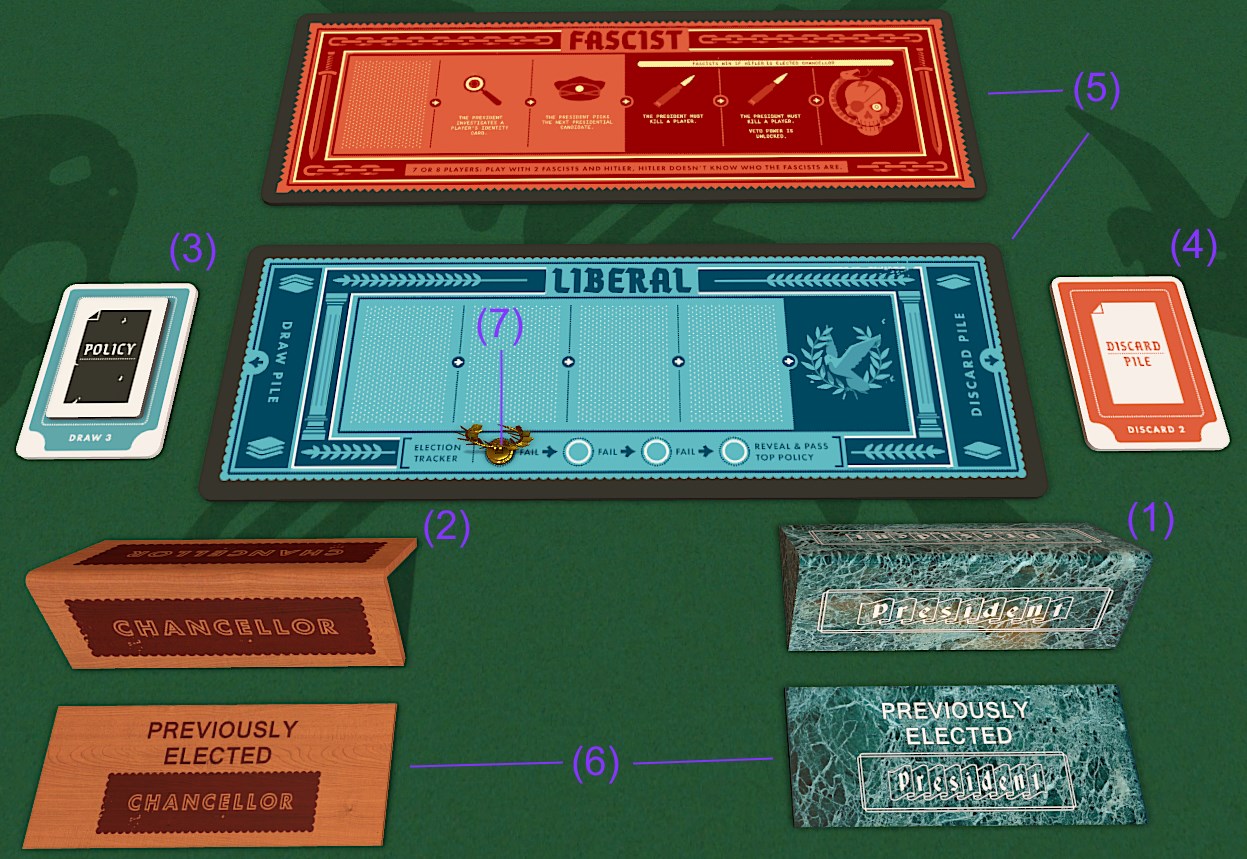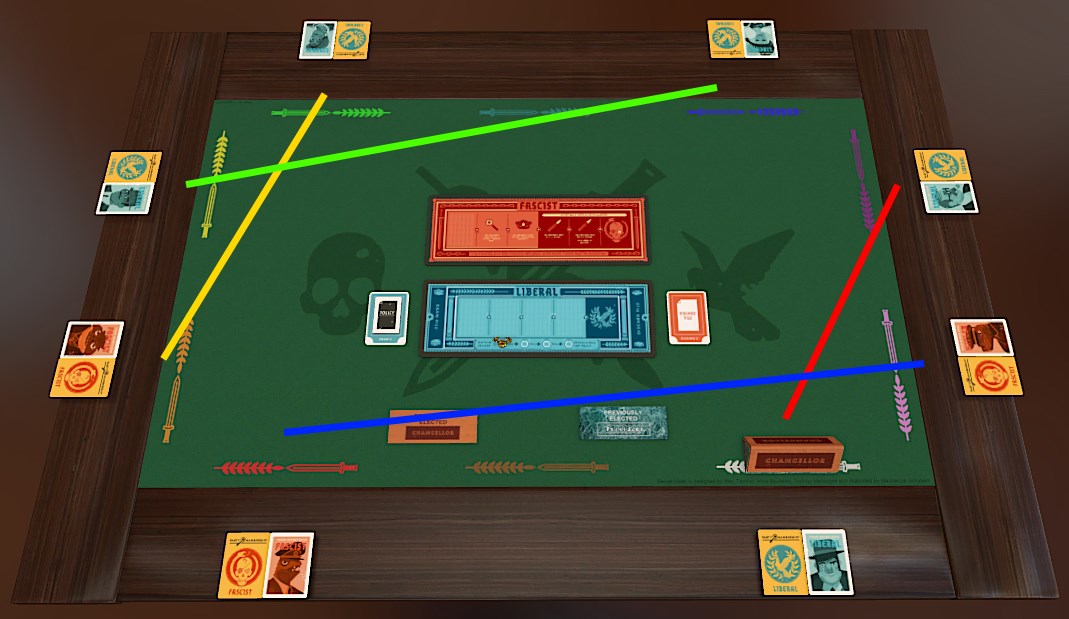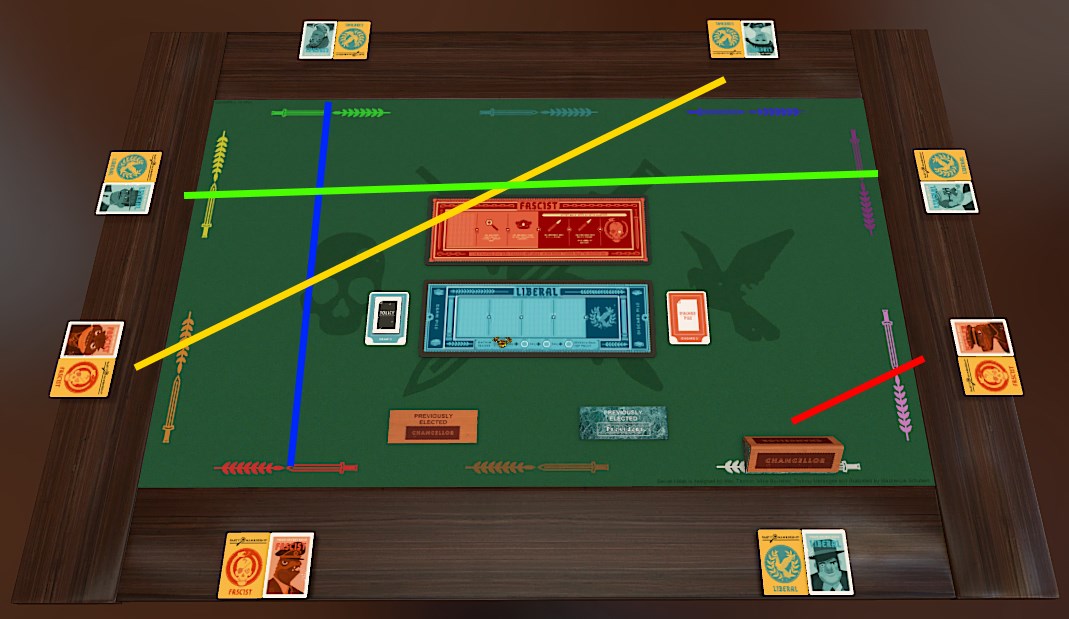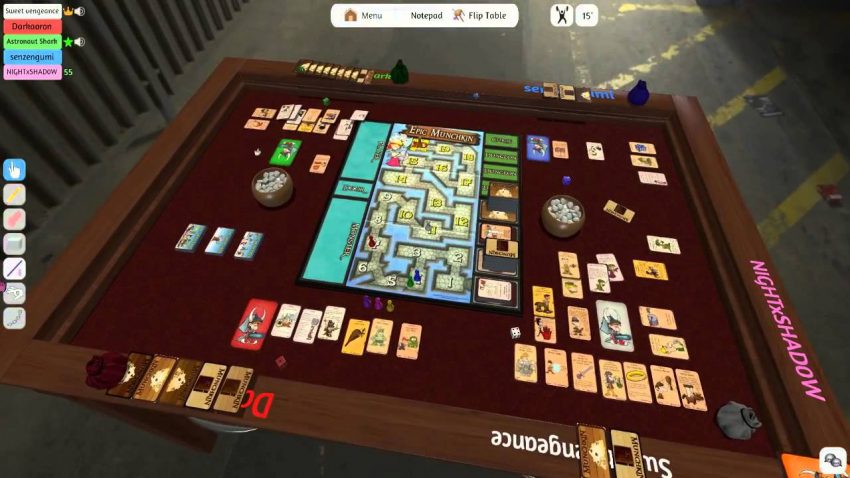This guide should be able to get you started with Secret Hitler, and can work as a reference in your first game or for future games on how to play. This guide is built around 8 player games, as it is the standard for Tabletop Simulator, although it should be able to applied elsewhere.
A more comprehensive, but less specific guide is available on SecretHitler.io’s website[secrethitler.io] (which also includes a free/browser version of the game!) if you would prefer to read that instead.
Introduction
NONE OF THE SPECIFIC GUIDES FOR LIBERALS, FASCISTS, OR HITLER ARE OUT YET! I AM WAITING TO DISCUSS WHAT TO INCLUDE IN THE ARTICLES WITH FELLOW PLAYERS FIRST!
Before beginning: the #1 rule to Secret Hitler is that all cards come out face down; your votes, policies, etc.
Secret Hitler is often viewed as a difficult game, but in all honesty, is fairly simple to play. There are many strategies to playing the game, and the name of the game is deception. There are multiple aspects to the game to understand, but before exploring any advanced techniques, it is best to cover the basics.
Also remember: there is NO wrong way to play the game!
Player Counts
In a game of 8 players, there are the following:
- 5 Liberals (the good guys)
- 2 Fascists (the bad guys)
- 1 Hitler (the super bad guy; does not know who his Fascists are)
This is ideal, although to go over the other 2 types of games in Secret Hitler, let’s go over both what 6 and 10 players ensues.
In a game of 6 players, there are the following:
- 4 Liberals
- 1 Fascist
- 1 Hitler (they knows who their fascist is, this is only true for 5-6 players)
In a game of 10 players, there are the following:
- 6 Liberals
- 3 Fascists
- 1 Hitler
In odd numbers of games (5/7/9 players), a liberal is removed. This is often very disliked because this makes the game unbalanced for reasons that are a bit too much to explain at the moment, although it is more important to go over the game itself before we fully go over why 8 players is important. We will revisit this, but it is important to get this out of the way for better understanding the layout of the game ahead.
Elections / Win Conditions
Let’s first talk about the most important portion of the game, which is required for any bit of action to occur: Elections!

This is a lot to look at with no explanation, so let’s go over the 7 highlighted pieces and what these mean, and what they do.
This person will be randomly assigned if you are playing on Consolidator Edition. The President’s purpose is to elect a Chancellor, which is given with the placard highlighted by (2) in the picture. The table will vote on this by flipping their ballot card face down and placing it on the table, and the vote will be determined as such.
If it is agreed upon, the president will draw three cards from the draw pile, marked (3) in the picture, discarding one in the pile marked by (4), passing the remaining two to their Chancellor. Both the President and Chancellor should not be discussing their cards until the Chancellor has put the remaining card out, and the Chancellor should claim first what they had. Claiming is important, as card counts are heavily considered when reflecting on the rounds later in the game.
If it is disagreed upon, the President’s placard will be moved to the next player in a clockwise order, and the election tracker, marked (7), will move forward by one.
The Chancellor is elected by the President, and is integral to the play just as much as the President.
If the play is agreed upon, the Chancellor will receive the two cards the President has left after discarding one, and will decide between the two cards left to play in either the Fascist or Liberal track, marked by (5), discarding the other card into the discard pile marked (4), then claiming what two cards they were given.
If the play is disagreed upon, the Chancellor will simply not be played to, and thus will be skipped unless chosen again by further Presidents.
The draw pile consists of 11 Fascist policies, and 7 Liberal policies. These numbers are important to considering what the draws may be, along with confirming the claims of what cards were drawn. A Fascist player will be bound to lie about their claim, hoping to confuse Liberals of the actual card count; thus why this is very important. This pile will reshuffle with cards from the discard pile marked (4) when there are 2 or less policies available.
Never discard cards in this pile! Always put them in the pile marked (4).
This pile simply is meant for the cards that are ditched by the President and the Chancellor. This should never be looked through, since the deception occurring in the game would be ruined if it were checked.
These are where the final card that the Chancellor has will be put. These should be explained separately, and we will review in particular how the powerups that the Fascist board has work.
Fascist Board
This board is where all Fascist policies are placed, and is integral for the Fascists to win. 6 policies are required for the Fascists to win, that or 3 policies are placed and Hitler is successfully voted in as a Chancellor afterward (the final 3 spots are considered “Hitler Territory”, which is the final part of the game). Anytime a Chancellor is successfully voted in, they MUST say if they are Hitler or not, as Fascists will have won if they are not, and the player will be confirmed “Not Hitler” if the game is not over.
In 8 player games, the board has four different powerups. These are the Inspect Power, Special Election, Bullet, and Veto. The President is the one who gains control of all three, only when the Fascist policy is placed over them, and there is only one of each, except for there being two Bullets. The President cannot use any powerup on their self.
The Inspect Power gives them the ability to check any player on the board if they are a Fascist or a Liberal (not Hitler, though). If they claim the inspected as a Fascist, they instantly are considered in a conflict (will be covered later). If they claim the inspected as a Liberal, both the inspector is considered on good terms with their inspected.
The Special Election simply allows the President to forcefully choose the next President, regardless of previous election placards marked by (6).
The Bullet forces a player out of the game, and is a method that the Liberals can use to win. If Hitler is shot, the Liberals instantly win. If Hitler is not shot, the player simply claims they are “Not Hitler”, and is not allowed to speak for the rest of the game, being considered Dead.
The Veto is unlocked by reaching the fifth and final Fascist policy spot before Fascists win, and allows both the President and Chancellor to completely discard their current cards if they both agree that they are unfavorable. If they both agree to veto, the presidency moves on, and the Election Tracker marked (7) moves forward by one.
Liberal Board
This board is where all the Liberal policies are placed, and is integral for Liberals to win. 5 policies are required for the Liberals to win, that or a Bullet powerup from the Fascist Board is used on Hitler. There are no powerups on this board in games with any amount of players.
These placards are given to the President and Chancellor previously in power, which restricts both of the players from seeing play as a Chancellor until the current round ends, in which the placards are passed on. The only way to bypass these is via a topdeck, covered by the section regarding the Election Tracker (7).
The Election Tracker is a piece that is below the Liberal board that moves forward by one every time an election fails, or if a Veto occurs. If three elections fail in a row, then the next President is forced to topdeck, or to forcefully play the next card on top of the draw pile marked (3).
Deception
With elections all out of the way, it is important now to figure out how exactly deception plays into this board. Refer back to the image above of the board if you need to understand certain parts of this section; they will be marked by their numbers once again here.
The goal of the Fascists is to provide the most favorable conditions for Hitler to look the best on the board, or to get all 6 Fascist policies out. They will likely lie about what cards they receive as a President, Chancellor, or something else in order to be played to. This is why understanding the card count as described in section (3) about the draw pile is integral to winning as a Liberal; you have to see if Fascists are overclaiming, underclaiming, or flat out getting into a conflict to avoid play to Liberals. Let’s go over what those three terms mean to get a better understanding.
This simply means to claim that you’re claiming that you received more cards of a certain type than you really did; this may engage you into conflicts with future Presidents if they realize the card count is incorrect based on your claims, or this may be sensed as you attempting to cover up plays from previous Fascists.
Example: As a President that is a Fascist, you draw one Fascist policy and two Liberal policies (FLL, this will be used to quickly notate card claims, so get used to this). You force your Chancellor two Liberal cards (LL), and after they claim they were forced, you claim you had three Liberal policies, despite only having two. This will confuse card claims, and may let you call out Liberal players for perhaps lying about their claim.
This means claiming that you received less cards than you actually did. This may confuse card counts, as there may be less Liberals than expected claimed, as it’d be rare to have anything less than four Liberal policies drawn (it is 100% not impossible for it to occur though).
Example: As a President that is Fascist, you draw one Fascist policy and two Liberal policies (FLL, again), and give your chancellor one of each (FL), often referred to as a choice. You then claim that you drew FFL, thus making the Liberals believe there are more liberal cards in the deck than there actually are.
These plays mean that the President and Chancellor do not agree on what cards were actually given, and thus forces them into a disagreement together, which we dub conflicts. Lines will typically be drawn to both the players in conflict, indicating it as such. This is useful for Fascists, as players in conflict will typically be considered for being shot via a Bullet, or being skipped as a President or Chancellor.
Example: As a President that is Fascist, you draw three Fascist policies (FFF) and give them to your chancellor, and after they claim they were forced (FF), you instead claim that you gave them a choice (FL). Thus, you are now both in conflict.
Alternatively: as a Chancellor, your President hands you a choice (FL), and you play the Fascist policy, and claim you were forced (FF). This would now put you both into conflict.
Liberals / Fascists
With Liberals, it is very important to try to figure out who else may also be a Liberal. It is best to sense this through the way they talk, interact with others, and based on what cards they have played as both a President and Chancellor.
These players should never lie, although there may be some fringe cases where it makes sense for a Liberal to lie (covered in the Liberal guide).
An important thing to note is that Hitler will most likely appear as a Liberal, in hopes of being elected after the board enters Hitler Territory. This is not always true, as Hitler may get into conflicts and may play rather ballsy. However, it is safe to assume that Hitler will usually be appearing as a Liberal player.
With Fascists, you typically want to appear Liberal initially, although do not be afraid to start conflicts and start deceiving other players regarding your cards. You ideally want to seal the deal for Hitler to become Chancellor in Hitler Territory, all without making it obvious who your teammates are. There are ways to signal your Hitler (as they do not know who you are), but this is covered in the Fascist guide.
The perfect world for Fascists is getting into conflicts that are easy to defend against; you want to look the best in your conflict, so consider card counts and claims before you get into a conflict. Sometimes, it may just be safer to underclaim or overclaim to keep yourself out of conflict for a little longer. Instant conflicts are certainly a viable strategy, however. Conflicts with your fellow Fascists or Hitler may even work too.
Tabletop Specific Notes
If you play any competitive video games, you may have heard the term “meta” thrown around. When it is used here, it is used to refer to the preferred route of the first four plays or so being made. We will review the two most popular metas used in 8 player games, and explaining their purposes. This has to do with where we want all the Presidents to play to.
To help you understand the order, the following colors correspond to the order (remember the Presidency moves clockwise!):
- 1st: Red
- 2nd: Blue
- 3rd: Yellow
- 4th: Green

This meta is considered inclusive, which means that all four plays should be made before breaking out of this meta. This makes sure every single player is played to, hopefully before Hitler Territory.

This meta is not inclusive, and is meant to skip to the most optimal player typically by the time the 2nd Liberal policy is passed.
These two aren’t the only metas for Secret Hitler, although they are the most popular. Some other popular ones include Mirror, Choo-Choo, 4 Ahead, among others.
